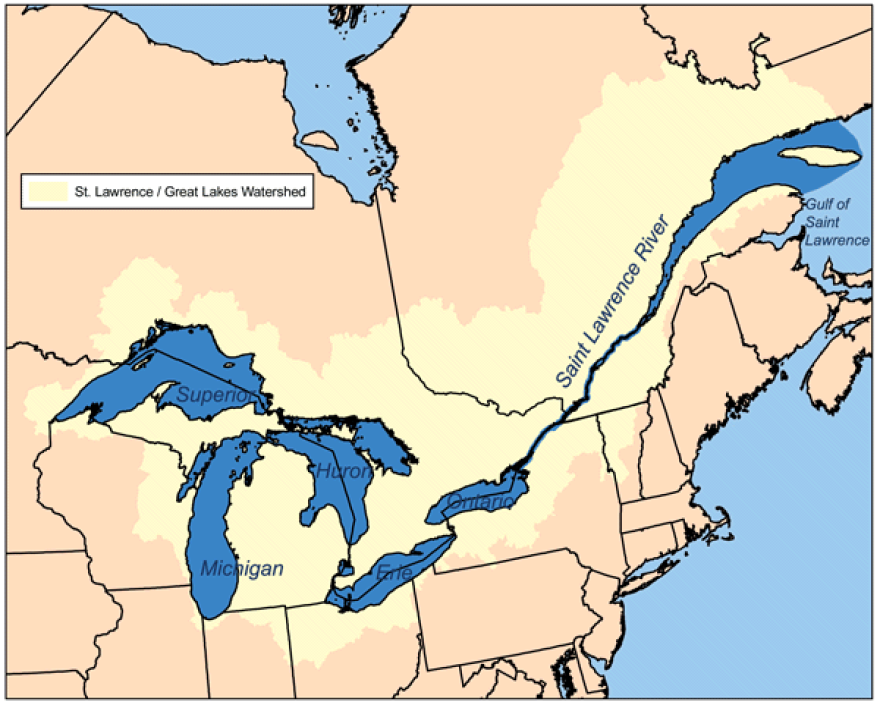A report by more than a dozen Midwestern scientists has found the Great Lakes are warming faster than the rest of the U.S., and stresses urgent action from state and local lawmakers.
The report commissioned by the Environmental Law and Policy Center aims to inform policymakers on how climate change has altered and will continue to shape the Great Lakes region, which includes five lakes, parts of Canada, and eight states from Minnesota to New York. University of Illinois Professor Don Wuebbles is the report’s lead author.
“Like the rest of the United States, the Great Lakes region has extensively warmed over the last century, and much more warming in the Great Lakes region is projected over the rest of this century," Wuebbles announces. "But climate change is much more than average temperature change. For the Great Lakes region there is also significant concern about the increasing intensity of severe events.”
Those “severe events” can at first seem contradictory. Instances of lake effect snow will increase, but overall snow levels and ice cover will decrease, according to the report. Residents will sweat through more 90-and-100-degree days in the summer, just as bitter “Polar Vortexes” could pass through in winter. And it’s that variability that destabilizes the status quo. Director of the Cooperative Institute for Great Lakes Research, Bradley Cardinale, says fluctuating water levels can easily affect Great Lakes markets.
“There’s a 2011 study by a Canadian economist named Frank Millard, who predicted that as little as a one-meter decrease in the lake levels of [Lakes] Michigan and Huron could lead to a 12 percent increase in shipping costs," Cardinale notes. "And that’s gonna translate to higher costs of doing business in the Great Lakes that will ultimately be passed on to consumers.”
Water levels have fluctuated considerably over the past few decades, and the report says that will continue. Wuebbles says increased flooding followed by periods of high evaporation are already affecting the region’s agriculture.
“Changes in the seasonal precipitation are affecting farmers with planting delays caused by spring flooding and excessively wet soil conditions," he says. "Hotter and dryer conditions later in the growing season increases the demand for irrigation to mitigate crop losses.”
Even with water management in agricultural watersheds, Wuebbles estimates corn and soy bean crop yields will drop 10 to 30 percent by 2050. Already shelling out for impacts on agriculture and updates to power plants, Cardinale says local communities will continue to pay for the effects of climate change.
“Climate change is also going to force local governments to make costly upgrades to other forms of infrastructure, like coastal roads that are going to experience larger storms and waves, water treatment plants that will have to contend with more algal and bacterial blooms, and sewer systems that will have to deal with larger storms," Cardinale explains.
Increased algal and bacterial blooms could frequently close beaches, threaten drinking water, and further disturb the area’s ecosystem. So what’s the solution? The report says lawmakers should focus on cleaner transportation and sources of renewable energy, like solar panels and wind farms. Executive Director of the Environmental Law and Policy Center, Howard Learner, says energy efficiency is the fastest and cheapest solution.
“Energy efficiency creates installation jobs, it saves residents and businesses money on their utility bills, and it keeps money, energy money, in our Midwest and Great Lakes economy," says Learner.
Meanwhile, the Trump administration has repeatedly proposed cuts to the Great Lakes Restoration Initiative, which aims to protect the lakes and their surrounding environment. Learner doesn’t believe any of those cuts will happen, but says it’s a sign the federal government alone can’t be trusted to protect the environment.
“While the federal government is not recognizing climate realities, it’s time for the states and cities to keep stepping up in terms of action," he notes.
Still, the Great Lakes region may fare far better than other areas of the United States. Lucinda Johnson of the University of Minnesota Duluth, says the lakes hold 21 percent of the world’s fresh water. She cites a recent presentation by Harvard professor Dr. Jesse Keenan.
“He’s proposing that Buffalo, New York and Duluth, Minnesota are two areas that are primed to become climate refuges for people that are escaping hot temperatures and drought in other parts of the United States," Johnson says.
The Environmental Law and Policy Center says roughly 34 million people depend on the Great Lakes for drinking water, jobs, travel, and more. The report can be found on the center's website.




